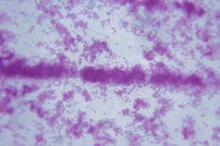5 Different Types of Bacteria
Bacteria are microscopic single-celled organisms that are all around us. They come in many different sizes and shapes, and this is a common way to classify them—by their morphology, or shape and appearance. The three basic shapes of bacteria are spherical, rod shaped and spiral. Spiral-shaped bacteria can be further categorized depending in part on how much spiraling they show. Not all bacteria are capable of causing disease, but each morphology-based group has at least some disease-causing representatives.
Coccus
Cocci are round, spherical bacteria. They may be single bacteria or they may occur in pairs, chains or clusters of bacteria, depending on the bacterium and environmental conditions. Cocci cause many different common illnesses. Among the more common cocci are Staphylococcus aureus, which appears as a cluster of cocci. Staph aureus often grows harmlessly in the nose and on the skin, but given a chance, this organism can cause:
- boils
- pneumonia
- meningitis
- even toxic shock syndrome—a rare
- life-threatening condition
Streptococcus pyogenes occurs as a chain of cocci and causes diseases that originate in the throat or skin, including strep throat and a related condition known as scarlet fever. Neisseria meningitidis occurs in pairs of cocci. This bacterium is an important cause of bacterial meningitis—a potentially life threatening infection, with inflammation of the brain and spinal cord.
- Cocci are round, spherical bacteria.
- Staph aureus often grows harmlessly in the nose and on the skin, but given a chance, this organism can cause: * boils
* pneumonia
* meningitis
* even toxic shock syndrome—a rare
* life-threatening condition Streptococcus pyogenes occurs as a chain of cocci and causes diseases that originate in the throat or skin, including strep throat and a related condition known as scarlet fever.
Bacillus
List of Common Pathogenic Bacteria That Affect the Human Body System
Learn More
Bacilli are rod-shaped bacteria that look like little sausages, occurring singly or in linked chains. Escherichia coli is a rod-shaped bacterium that normally lives in your intestinal tract without causing disease, however it can cause disease at other sites, such as the urinary tract. Some strains of E. coli are spread by eating or drinking contaminated food or water, causing diarrhea and potentially more widespread illness in some individuals. Corynebacterium diphtheriae, another rod-shaped bacterium, infects the respiratory tract and causes diphtheria, a vaccine-preventable disease. Bacillus anthracis is the cause of anthrax. This rod-shaped bacterium grows in long chains, can infect you through broken skin, ingestion or inhalation and is therefore considered among the organisms that have bioterrorism potential.
- Bacilli are rod-shaped bacteria that look like little sausages, occurring singly or in linked chains.
- This rod-shaped bacterium grows in long chains, can infect you through broken skin, ingestion or inhalation and is therefore considered among the organisms that have bioterrorism potential.
Vibrio
Members of the vibrio group represent one of the three types of bacteria that have a spiral shape. Vibrio bacteria are comma-shaped, appearing like curved rods. They typically live in aquatic environments and move in a darting motion using a single flagellum, a whip-like structure. Vibrio cholerae causes cholera—an intestinal infection that causes severe diarrhea and dehydration. Drinking water contaminated by feces transmits cholera, and epidemics may occur after natural disasters and in developing countries due to poor sanitation. Cholera is a very serious disease that can lead to death if not treated promptly 3.
- Members of the vibrio group represent one of the three types of bacteria that have a spiral shape.
- Drinking water contaminated by feces transmits cholera, and epidemics may occur after natural disasters and in developing countries due to poor sanitation.
Spirillum
A List of Fungal Diseases
Learn More
Spirilla are another subgroup of bacteria with a more rigid, corkscrew-like spiral shape. One such bacterium is Campylobacter jejuni, a cause of foodborne illness and diarrhea. Campylobacter jejuni is typically acquired in places where sanitation is poor or by eating raw or undercooked poultry. Campylobacter is among the most common causes of diarrheal illness in the United States. Helicobacter pylori is also corkscrew-shaped bacteria, and it thrives in the stomach, where it burrows into the lining. Helicobacter pylori may be living in a person’s stomach without causing symptoms, but this organism is also associated with stomach inflammation and ulcers in many people.
- Spirilla are another subgroup of bacteria with a more rigid, corkscrew-like spiral shape.
- Helicobacter pylori may be living in a person’s stomach without causing symptoms, but this organism is also associated with stomach inflammation and ulcers in many people.
Spirochete
Spirochetes are long, thin and flexible corkscrew-shaped bacteria. They typically move in a distinctive rotating manner that allows them to be mobile in mucus-lined tissue or viscous environments. Two well-known spirochetes that cause disease in humans are Treponema pallidum and Borrelia burgdorferi. Treponema pallidum causes the sexually transmitted disease syphilis. Infection typically begins as a single sore at the site of infection. Additional lesions or rashes can develop elsewhere on the body if left untreated. Borrelia burgdorferi is transmitted through the bite of an infected deer tick and causes Lyme disease 3. Infection with Borrelia burgdorferi may, but does not always, result in a typical "bull's-eye" rash. If left untreated, it can affect your heart and nervous system and cause arthritis.
- Spirochetes are long, thin and flexible corkscrew-shaped bacteria.
- Borrelia burgdorferi is transmitted through the bite of an infected deer tick and causes Lyme disease 3.
Related Articles
References
- Robbins Pathological Basis of Disease; Ramzi Cotran, et al.
- Lippincott's Illustrated Reviews: Microbiology; Richard Harvey, et al.
- Clinical Infectious Disease: Prospective Study of Serologic Tests for Lyme Disease
Writer Bio
Leann Mikesh holds a Ph.D. in pathology. She has trained at the University of Virginia Medical Laboratories and has over 15 years experience in clinical, cancer and immunology research. Dr. Mikesh performed kidney and bone marrow transplantation compatibility testing to put herself through graduate school.









